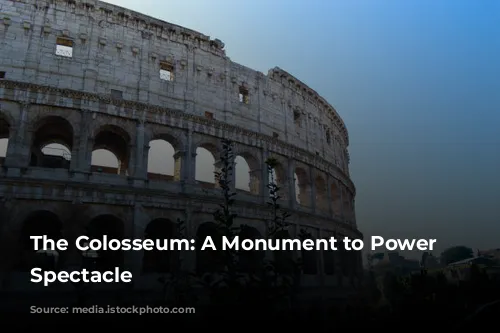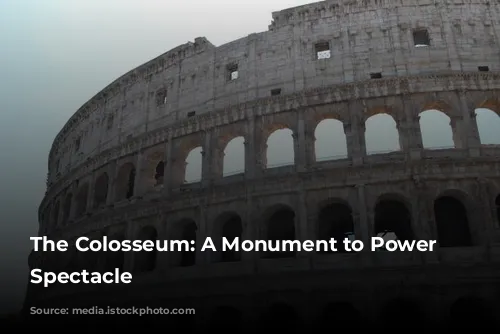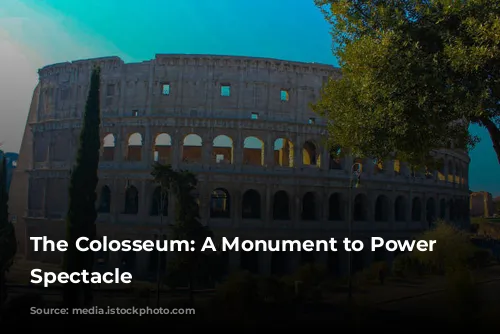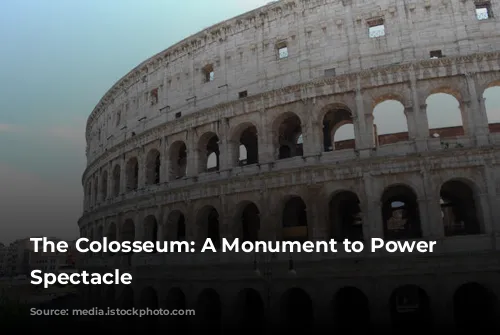The Colosseum, also known as the Flavian Amphitheatre, stands as a towering testament to the grandeur of the Roman Empire. This imposing structure, the largest amphitheatre in the Roman world, is not only a symbol of Roman power but also a window into their fascinating culture.
A Monument Built by Emperors
Emperor Vespasian, a member of the Flavia family, initiated the construction of this magnificent edifice. His son, Titus, completed the project and inaugurated the Colosseum with a grand opening ceremony that lasted for one hundred days. This extravagant celebration showcased breathtaking spectacles – thrilling gladiatorial combats, captivating animal hunts, and awe-inspiring naumachiae, real sea battles recreating historical naval clashes.
The Origins of the Colosseum’s Name
Why is this architectural marvel universally known as the Colosseum? The origin of this name can be traced back to a prophecy by the Venerable Bede, a medieval monk. He declared, “Rome will exist as long as the Colosseum does; when the Colosseum falls so will Rome; when Rome falls so will the world.” This prophecy, perhaps influenced by the colossal statue of Emperor Nero, the “Colossus,” which stood near the amphitheatre, cemented the name “Colosseum” in the collective memory.
A Masterpiece of Roman Architecture
The Colosseum’s impressive design is a testament to the Romans’ architectural genius. Imagine this massive structure, once entirely covered in gleaming travertine stone, its elliptical shape perfectly designed to accommodate a vast audience. The building boasted four levels, with the first three levels each featuring 80 arches, adorned with majestic statues. This impressive edifice, built in less than ten years, showcases the remarkable efficiency and skill of Roman engineers.
The Secret of the Colosseum’s Construction
The Romans excelled in an architectural technique that allowed them to create breathtaking structures: the arch. This ingenious design effectively distributed the weight of massive constructions, making it possible to build structures like aqueducts that defied gravity. The Colosseum, with its tiered arches, resembles a series of aqueducts stacked on top of each other.
A Building Stripped Bare
Today, we see only a skeleton of the once magnificent Colosseum. Over time, much of the original structure has been dismantled, with its marble, lead, and iron components repurposed for other construction projects throughout Rome. The holes visible on many columns serve as stark reminders of the Colosseum’s history as a quarry, its stone and metal used to build structures like Barberini Palace, Piazza Venezia, and even St. Peter’s Basilica.
A Seat for the People
The Colosseum could hold up to seventy thousand spectators, providing a panoramic view of the arena for all. Entry was free for Roman citizens, but seating was assigned based on social status, much like modern theaters. The top tiers were reserved for the common people, with separate sections for men and women. As one moved closer to the arena, the social standing of the spectators increased, with senators, vestals, priests, and the emperor occupying the front rows.
A Colosseum Covered in Sunlight
Like modern sports stadiums, the Colosseum provided protection from the sun. A clever system of ropes, winches, and wooden poles supported an enormous linen tarpaulin known as the velarium. Operated by a hundred sailors from the Imperial fleet, the velarium was meticulously adjusted by the rhythmic beat of a drum, ensuring a pleasant viewing experience for the audience.
The Arena and its Secrets
As we enter the Colosseum, we see the arena, the stage for the spectacles, now devoid of its original brick and wood floor. Beneath the arena floor, the Colosseum’s hidden cellars reveal the complex systems used to stage the games. Underground lifts and hoists, remnants of which are still visible today, were used to surprise the audience with the sudden appearance of animals and gladiators through trapdoors, creating a thrilling spectacle.
Beyond the Arena: The Shows
The Colosseum hosted a diverse array of shows that entertained and captivated the Roman populace. Venationes, or animal hunts, were popular events, featuring battles between exotic beasts and men. The Silvae, elaborate sets recreating forests with animals, were another captivating spectacle.
The Colosseum and the Gladiators
The gladiators, the stars of the Colosseum, entered the arena through a secret passageway linked to their barracks, the Ludus Magnus. Greeted by enthusiastic fans, these skilled warriors were celebrated like today’s sports heroes. Gladiators, a diverse group of individuals, often comprised prisoners of war, who chose the arena over slavery, or individuals seeking fame and fortune.
The Rules of the Arena
Gladiatorial combat was a spectacle of skill and strategy. Gladiators wielded various weapons, from nets and tridents to shields and sickles. If a gladiator was wounded, he could appeal for mercy, raising his arm to the audience. The emperor, seated in his designated area, had the final say on the gladiator’s fate, granting mercy with a thumbs up, or death with a thumbs down.
The Colosseum: A Legacy of Blood and Entertainment
The Colosseum was a place of immense entertainment, but also of violence. Roman spectators were captivated by the spectacles, often relishing the brutality of the events, a fascination comparable to modern-day “splatter” films. The smell of blood, burnt flesh, and wild animals permeated the air, a stark reminder of the realities of these spectacles.
A Monument Transformed
After the decline of the Roman Empire, the Colosseum fell into disuse, becoming a shelter for various groups and even a cemetery. During the Middle Ages, the Colosseum was deemed a sacred monument dedicated to the Passion of Christ. A cross placed on a pedestal, symbolizing the suffering of Christian martyrs, marks the starting point for the Stations of the Cross on Good Friday, a tradition that continues to this day.
The Colosseum: An Everlasting Symbol
The Colosseum stands as a testament to the grandeur and brutality of the Roman Empire. Its imposing structure, once covered in dazzling travertine, now a skeleton of its former self, whispers tales of gladiators, emperors, and the Romans’ thirst for entertainment. The Colosseum, a symbol of Roman power and spectacle, continues to captivate the world, its silent stones echoing with the echoes of a bygone era.






